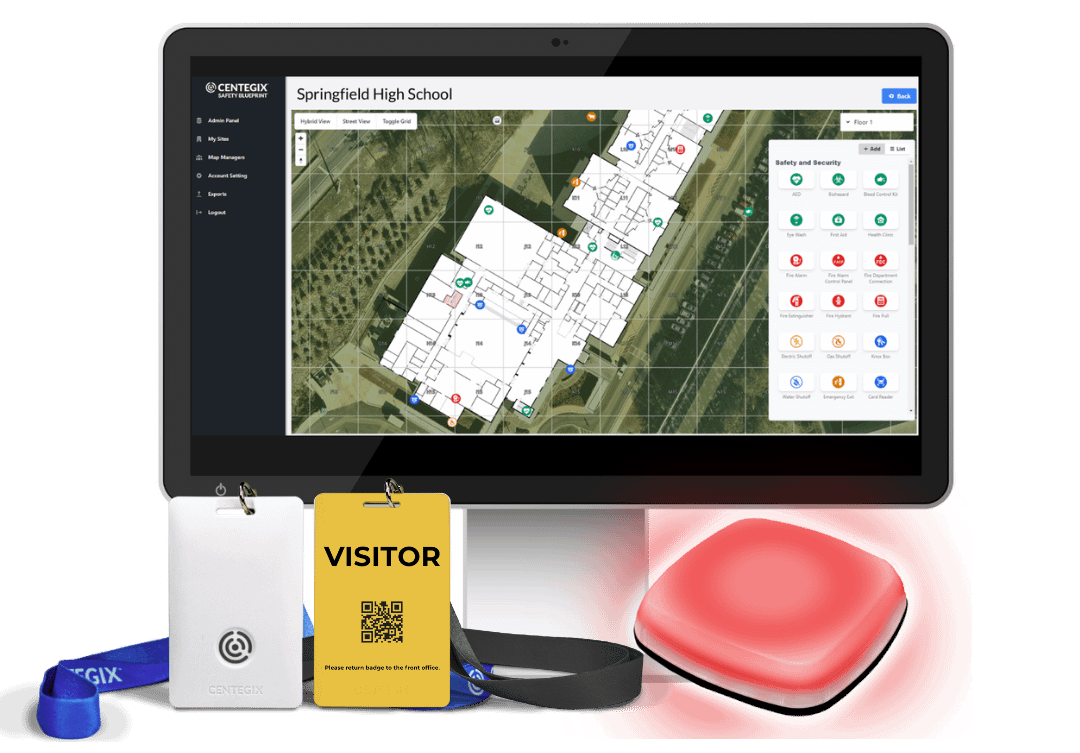Colleges and universities are constantly evolving to better serve students, faculty, and campus communities. While higher education institutions face unique challenges such as integrating ever-advancing technology, addressing mental health issues, and promoting diversity and inclusion, one thing is certain—safety should be the foundation for any learning environment.
As 2024 progresses, college leaders face safety hurdles that stem from technological, societal, and economic factors. Whether leaders plan to expand the campus, improve facilities, or increase course offerings, colleges and universities must prioritize campus safety and security at every level. To enhance safety, many campuses are choosing to implement innovative technology, like school alert systems that incorporate wearable panic buttons, critical incident mapping software, and visitor management technology.
Let’s review the current state of safety on US college campuses and how implementing the right safety technology can foster a culture of safety for your students.
Safety on College Campuses Today
Safety is one of the most challenging pursuits university leaders currently face. A safe environment is crucial for all students’ academic and social development, and is a main factor when students are considering where to study. According to a 2022 survey, 60% of undergraduate and graduate students reported they weighed campus safety heavily when choosing where to go to school.
In 2023, the US Department of Education published that over 38,300 crimes were reported on college campuses in the United States with over 16,500 of those cases classifying as violence against women. Understanding the broader implications of campus safety becomes crucial, as it directly impacts not only safety but students’ perception of security. These perceptions are closely linked to academic success and mental health.
Research shows that students’ perception of safety is directly related to academic achievement. When students do not feel safe, their mental health, attendance, and academic performance can all suffer negative effects. Additionally, faculty and staff need to feel safe to do what they do best—help students learn and grow.
Unique Safety Challenges in Higher Education
Colleges and universities, unlike other organizations that operate within a single building, face several challenges related to campus size and population:
Expansive campuses and multiple buildings. Colleges and universities can have multiple buildings across many acres or even multiple campuses spread across the state, making it difficult to monitor all areas on campus. For example, the largest college campus in the US, located in Georgia, stretches over 27,000 acres in total. When you lack that visibility, emergency response times can increase, putting lives at risk.
Communication gaps. Quickly getting help is the most important factor in emergency situations. Older buildings on college campuses often present unique challenges to communication due to their construction, such as thick walls that interfere with signal strength, outdated wiring, and architectural layouts that complicate connectivity. College campuses need a solution that can work anywhere on campus and eliminate those gaps left by other solutions.
Vulnerable areas. Campuses contain many areas that are more vulnerable to safety incidents, such as parking lots, dorms, science labs, and isolated walkways. You need a safety solution that protects those vulnerable areas.
High foot traffic and events. Campus tours, sporting events, lectures, greek life, and many other activities can bring familiar and unfamiliar people to school grounds, creating an additional challenge to keeping your campus safe and secure.
A Culture of Safety for Your University
Investing in the right safety technology can address the unique safety challenges in universities. Innovative emergency alert systems and automated wearable panic button technology make quicker emergency response possible. With the push of a button, a safety alert instantly reaches administrators and responders, displaying a map of who needs help and where they are located. Security teams can monitor alerts in real time, enabling an accelerated response and support. No delay, no valuable seconds lost.
The right school alert system will also deliver total campus coverage. A private, managed network can cover every square foot of campus. Whether your campus spans seven buildings, seven acres, or seven counties–your request for help instantly reaches responders, with no Wi-Fi or cell signal needed.
Seamless integration is also critical when selecting an emergency alert system for your university. A safety platform should integrate with a school’s multi-layered safety plan. New safety technologies must interface effectively with existing systems, including desktop displays, video cameras, SISs, PSAPs, and intercom systems. The right platform will also address niche communication issues that aren’t obvious, such as a school’s access control systems and visitor management systems.
Emergency alert systems and wearable panic button technology can also provide precise location details on your college campus, down to an individual floor and room, so first responders know exactly where their help is needed when an emergency strikes. Regardless of your campus’ size, help gets to the right location quickly. As always, discretion is key. Wearable panic button technology should be discreet and designed to work without further escalating the situation.
In an interview with CENTEGIX, James Perry, Chief of Police at West Georgia Technical College, said:
“Recently, we’ve been averaging about two students a week with medical issues, and we’ve had to call ambulances in. Our staff has gotten so comfortable that they’re hitting it [the badge button] now…Our response time has been in seconds, not minutes, and it’s been fantastic for us.”
Before implementing CENTEGIX, they relied on outdated PA systems and cell phones which were not reliable in emergencies.
CENTEGIX has been successful in educational institutions across the country. Stacey Locke,
Deputy Superintendent at Yakima School District in Washington stated the following:
“For our staff, it has been mindblowing [with the badge and the safety network having access to CENTEGIX technology], they now feel valued. We now have 2,000 additional eyes and ears on the safety of not only Yakima School District but also the community as a whole and I can tell you what a difference that has made when we talk about a comprehensive culture of safety.”
The CENTEGIX Safety Platform™: The Foundation of a Multi-layered Safety Culture
The CENTEGIX Safety Platform™ makes it easy for higher education institutions to foster a culture of safety through accelerating emergency response. Here’s what we offer:
CENTEGIX Safety Blueprint™. With Safety Blueprint, colleges and universities own their maps and mapping data, enabling them to quickly and securely share with law enforcement and first responders. With CENTEGIX Safety Blueprint, staff can easily collaborate with different teams on campus and follow safety protocols for a better outcome.
CENTEGIX CrisisAlert™. CrisisAlert was initially created to reduce response times when unthinkable emergencies happen. When CENTEGIX was designing the CrisisAlert wearable panic button, it prioritized insights from those directly impacted by campus emergencies. With our CrisisAlert wearable panic button, faculty and staff can quickly and discreetly request help at their exact location. Because in a crisis, every second matters. The wearable panic button provides two types of alarms:
The Staff Alert is meant for everyday incidents, including medical emergencies and physical altercations. It notifies local administrators and responders immediately and displays a map showing who needs help and where they’re located on campus.
The Campus-wide Alert instantly initiates a campus-wide rapid response to emergencies. It notifies 911 dispatch, activates full audio and visual communication, and delivers precise location details with a map displaying who needs help and where they’re located.
CENTEGIX Visitor Management. Whether you’re expanding your campus, upgrading your facilities, or anything in between, you need a way to keep track of independent contractors, vendors, and any other temporary guest with access to restricted areas. Enhanced Visitor Management locates visitors in real-time, informing first responders and administrators during an emergency.
The CENTEGIX Safety Platform integrates seamlessly with your other safety investments and public safety agencies to supplement your safety plan. Colleges and universities can leverage assets they already have, including radios, intercoms, IT networks, and access control, to use in an incident with Safety Blueprint and CrisisAlert.
Every second matters.® The CENTEGIX Safety Platform, featuring the Safety Blueprint critical mapping technology and CrisisAlert wearable panic button, makes a layered and tested campus safety plan possible. CENTEGIX is a national leader in developing innovative safety solutions that empower and protect people every day. The CENTEGIX Safety Platform utilizes dynamic digital mapping, real-time visitor locating capabilities, and an easy-to-use wearable emergency button to plan for and respond faster to emergencies.
Click here to learn more about what we can do for your higher education institution and to see a demo of the CENTEGIX Safety Platform.













